Staying Power
July 31, 2024
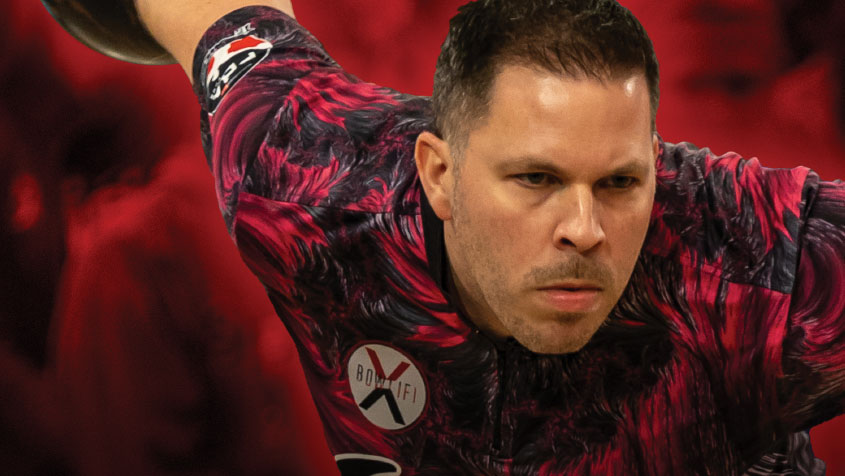
Fourteen years ago, while he was in the midst of a breakout season on the PBA Tour during which he won his first career PBA Tour title — the 2009 Chameleon Championship — I wrote an article about Bill O’Neill for this magazine. In it, I wrote that, “Bill O’Neill has become one of the tour’s elite players, and I’d be surprised if he didn’t stay that way for a long time.” The man now is 42 years old, nearly 20 years removed from officially becoming a PBA Tour member in 2005, and he has, once again, experienced a career year on the PBA Tour. A long time, indeed.
O’Neill kicked off the 2024 PBA Tour season by winning his third career major, the PBA Players Championship, on Jan. 15 in Wichita, Kansas. It was his 14th PBA Tour title overall. The next event on the tour’s 2024 schedule also was a major — this time, the U.S. Open, an event he previously won in 2010 — and, once again, O’Neill made the show, finishing fifth following a squeaker of a loss to EJ Tackett in the show’s opening match, 212-209. Any player on tour would be elated to experience such a start to a season. But O’Neill was not done.
A couple of events later, O’Neill advanced to the title match of the PBA Pete Weber Missouri Classic, losing a lopsided contest to Anthony Simonsen, 224-156, but leaving that event the clear frontrunner in the PBA Player of the Year race. In early March, he made yet another show, the time advancing to the semifinal match of the Delaware Classic, where he fought David ‘Boog’ Krol to a 203 tie but lost in the rolloff. His season culminated with a third-place showing in the PBA Playoffs, and a season a player of any age would be thrilled to have experienced, no less a player nearing his mid 40s as a professional athlete.
In some ways, yes, O’Neill’s longevity is unsurprising. The man is a match play-making and cashing machine, and his well-assembled, sturdy game (the work of father Bill O’Neill Sr.) is a big part of the reason why. His fundamentals enable him to stay out of trouble often, and his equally sturdy mental game helps him hugely in that regard as well.
Along the way, as he has battled season in and season out to stay a cut above most on tour for nearly two decades, several features of his game help explain the man’s staying power as a tour player — his timing, his stance, changes he had made in his approach to targeting, and his insistence on letting the ball be his guide rather than relying on external information such as lane graphs as he unpacks the riddles of a given center’s conditions.
Timing and Swing
While O’Neill places heavy emphasis on his mental game as a means of explaining his longevity, and while there is much to be said for the benefits a solid mental game can bring to a player’s overall tool box week to week, O’Neill’s timing and his swing help provide at least as much explanation for his ability to remain a top player at age 42. These are the kinds of physical assets that stand the test of time.
O’Neill’s timing is underscored by three keys:
1. Where the ball is located on the third step of his five-step approach.
2. His ball and swing’s readiness to come down when he enters his slide.
3. The timing with which his ball comes off of his hand at the release.
Great timing facilitates longevity because it reduces stress on the body, allowing one’s approach to flow effortlessly. Generally speaking, there are two critical places the swing and ball need to be to establish ideal timing.
Firstly, the ball needs to be past the right leg (for right-handers like O’Neill) on the backswing during the third step of a five-step approach or the second step of a four-step approach (See Photo 1). This is the position that the great Don Johnson called “the pro zone” in 1979 when I was evaluating student videos at his camp. But don’t just take it from me or, for that matter, Johnson.
PHOTO 1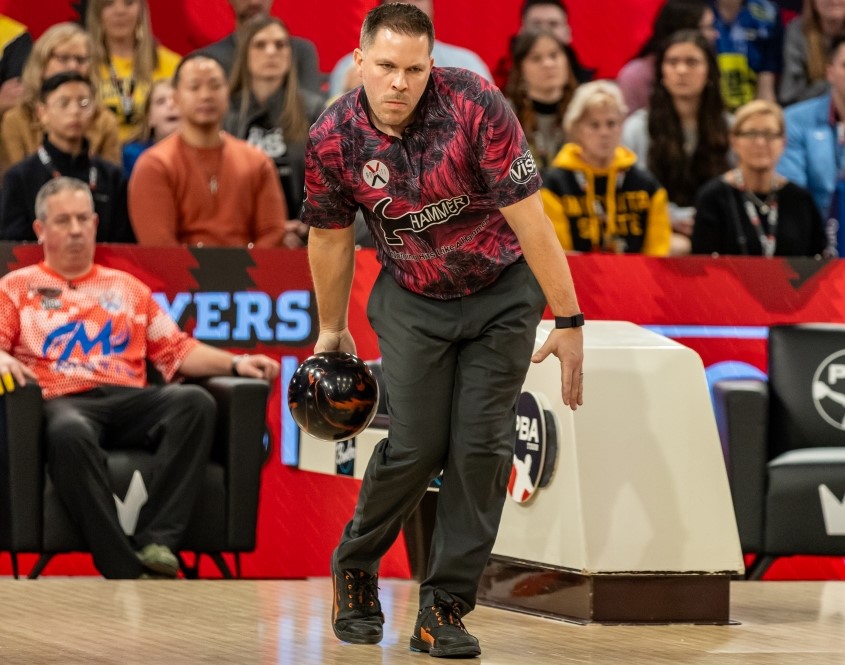
A Test of Timing: This step in O’Neill’s approach exemplifies the kind of timing that leads to longevity.
A slew of players In addition to O’Neill have or had games that feature this hallmark of great timing, including Mark Roth, Parker Bohn III, Norm Duke, Pete Weber, Jason Couch, Brian Voss, Chris Barnes and plenty of others. More contemporary players, like Kris Prather, Andrew Anderson, EJ Tackett, Marshall Kent and many others also exhibit the same signature of great timing. These are players who do one thing that great timing requires — they get that ball past the bowling-side leg before that foot moves forward.
Secondly, O’Neill’s timing is picture-perfect when he enters his slide. His ball is directly behind his head — about one ball width above his head, specifically. His left arm is extended directly out from the shoulder, his thumb pointed down and palm facing back. This helps to firm up his left side, increasing his speed and stability. O’Neill has enough forward tilt to enable his head to stay over the slide foot as it moves forward.
It is at this moment in O’Neill’s approach that his swing needs to be moving forward with his slide step. This produces an effortless descent of the ball to the release, with the arm, ball, and core of the body all moving in the same direction. This entails effective use of gravity to generate speed and effortless movement on his last step.
Consider the alternatives to the effortlessness seen here. For instance, if the swing were still going up when O’Neill’s slide step starts moving forward, his ball and foot would be going in opposite directions, which steepens the swing as it comes down and requires a lot of muscle to get the ball to level out to the lane for release. Steeper swings cause bigger misses relative to the timing of the ball off the hand. Sure, some players have had success doing it this way, but it is much harder on the body and requires a great deal of physical strength to generate speed and a powerful, consistent release.
O’Neill’s position in Photo 2 presents as good a model as one can get for executing the best position when entering one’s slide.
PHOTO 2
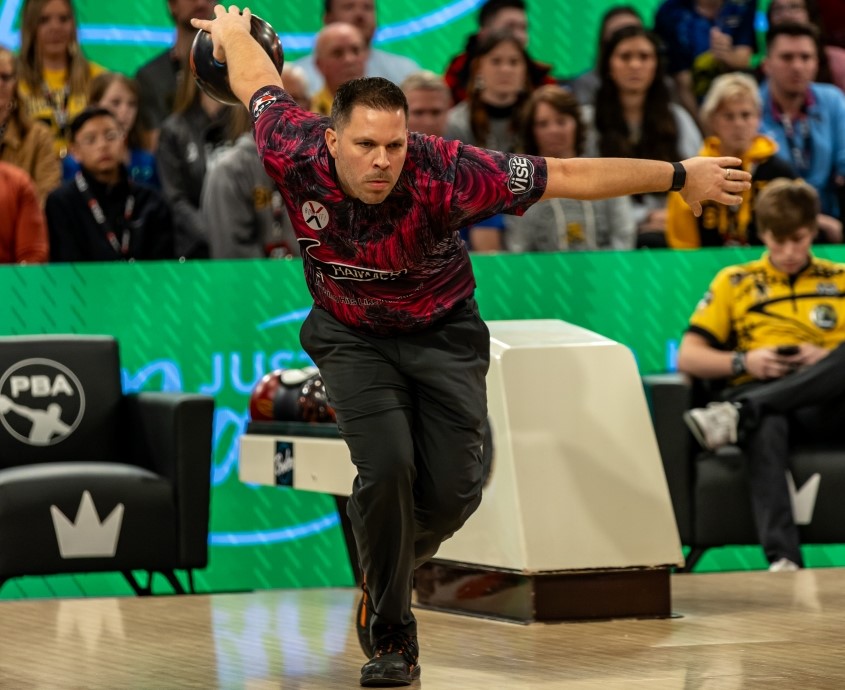
Like a Rock: At age 42, O’Neill has proven that his game was built to last.
Stance at a Glance
One of the key changes O’Neill made to his game that helped him experience a resurgent season this year is in the area of his stance. Photos 3 and 4 depict two very different ways he has built his stance over the years. Photo 4 depicts a setup O’Neill was using in an attempt to increase his speed and rev rate over the past couple of seasons. Standing with his left hand in front of his right enabled him to cup the ball more as a means of enhancing his rev rate. But there was a problem: It also created a lot of tension, which impeded his start, swing, and approach. For all the talk thus far of the effortlessness of O’Neill’s game, here he experienced much the opposite. No longer was his game as free and loose as it had been for so long.
PHOTO 3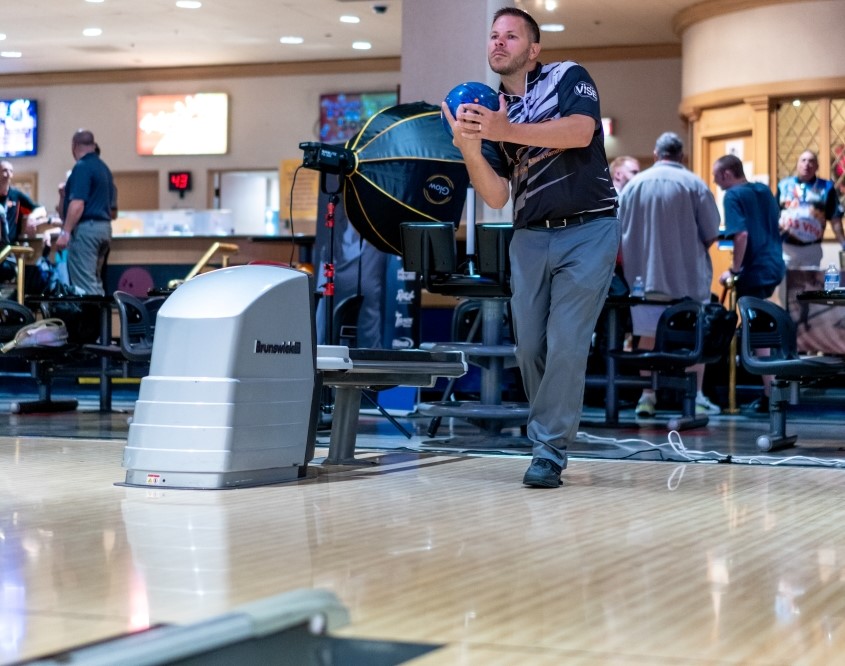
PHOTO 4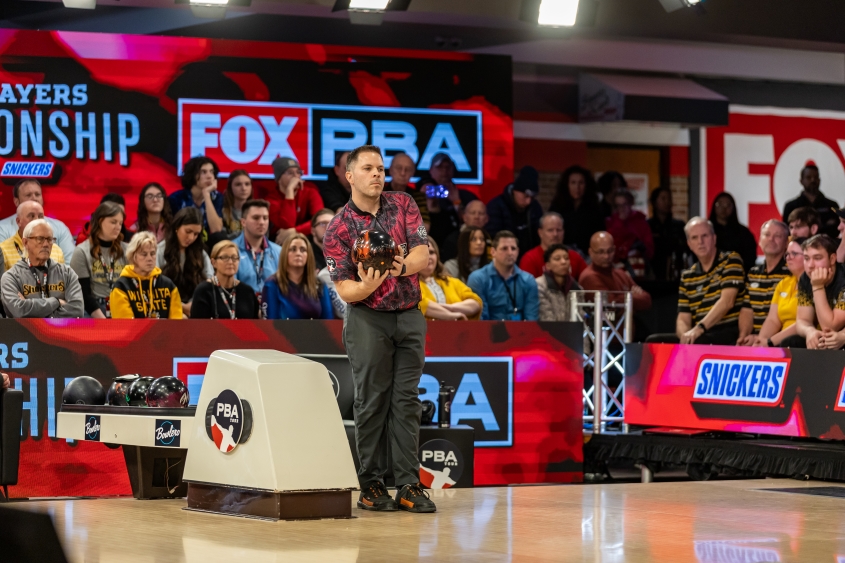
Stance Study: The stance in Photo 4 is one O’Neill adopted to increase rev rate, while the one in Photo 3 is the picture-perfect stance any player would be wise to use as a model.
So he went back to the stance shown in Photo 4, which is a great stance for a number of reasons. Notice that he is cradling the ball, with his right hand under the ball and in front of his right shoulder. Furthermore, his forearm is facing his target line, with the majority of the ball’s weight resting on his right hand.
Essentially, his left hand counterbalances the ball here, with the tips of his pinkie fingers almost touching each other. Unlike the more recent stance of the past two seasons, this one sets him up with less tension so that he is ready to start more freely.
One thing bowlers back home should draw from this is that the stance is the first part of one’s game that needs to be built, and that it needs to be done with attention to detail. Know what you are doing with this element of your game. How are you building your stance, and why are you building it that way? Have answers to these questions.
The bottom line Is this: A good setup leads to a good start, which often leads to a good ending. Do not take your stance lightly.
Lane Play
Another important change O’Neill has made to his game over the years involves his approach to targeting. While he used the arrows for many years, more recently he has expanded it by targeting farther down the lane when his intention is to stand left and throw right.
O’Neill particularly enjoys getting the ball out to around the 6 board whenever possible because, in his experience, the ball’s angle of entry into the pocket from there provides optimal carry.
One aspect of O’Neill’s approach to lane play that has not changed is his aversion to dependency on lane graphs. O’Neill is as familiar with the spectacle so many tournament bowlers have seen, or themselves participate in, in tournament after tournament: gaggles of players squinting at lane graphs on some paddock wall, and talking with one another about the secrets it reveals. You know who does not partake in that activity, in O’Neill’s experience? Some players with whom you might be familiar: Norm Duke, Walter Ray Williams Jr., Pete Weber. Rumor has it that those guys have done a thing or two on the lanes.
Wisely, O’Neill took his queue from those greats by taking an old adage to heart: Let the ball be your guide. He lets his ball reaction tell him what two do, and he observes great players to get real-life information on what they are doing in a given environment. In O’Neill’s view, too many players get wrapped up in preconceived notions about what the lanes will do and how to play them.
Even in situations in which he goes into a bowling center with no idea what’s on the lanes and no one to watch, he still practices self-reliance with a specific strategy. In this situation, he often will start out playing as far to the right as possible — out near the gutter. In O’Neill’s experience, every pattern has the least amount of oil near the gutter, with the exception of a truly flat pattern. If his ball hooks off the gutter, O’Neill will move in to find hold. In all honesty, this is a pretty logical way to begin a bowling session even in familiar environments. Always look for the most friction first by starting out near the gutter.
One physical tool O’Neill uses to play the lanes the way they require in a given environment involves the way he manipulates grip pressure. When he wants to increase his rev rate and ball rotation, he will tuck his pinkie finger and apply more grip pressure with his fingers. If he wants to reduce his rev rate, he will untuck his pinkie finger and lighten up his grip pressure. O’Neill has greatly expanded his ability to do this over the years to deploy various approaches from a big hook to a straighter game.
General Observations
It is easy to take for granted a season like the one O’Neill had this year. After all, he is a three-time major champion who, as long ago as the 2009-10 season, tied Walter Ray Williams Jr. (and Mike Scroggins) in PBA Player of the Year points. His face has, to say the least, become a familiar one on PBA Tour telecasts over an extended period of time now. However, that familiarity belies some struggles O’Neill has had to face down along the way that explain his disappointing (by his standards) seasons in 2022 and 2023.
Really think about the span of time O’Neill’s career now entails, and then consider the abundance of technological change that has occurred over such a period. Oils, oil patterns, lane surfaces, bowling balls. It is all a challenge to stay on top off for as long as O’Neill has done so, but that is essential for a player who is going to stay relevant for as long as he has.
O’Neill’s mental game is such that he always has coupled that curiosity with accountability, often looking inward for answers at times when he feels lost. It is in those moments that players must determine if the problem is them, their equipment, or the lanes. O’Neill believes the problem always rests with him, and tackles hurdles as they emerge over the course of a tournament from that standpoint.
That mental fortitude became particularly necessary when, last fall, O’Neill suffered a back injury resulting from a herniated disc with which he has struggled since college. He took two months off, got a Cortisone shot, and made adjustments to his fitness regime. Specifically, whereas he once favored heavier weight lifting, these days he emphasizes flexibility and uses lighter weights in his workouts. He also practices yoga, along with other stretching techniques, to remain flexible. The situation with his back makes this a paramount need for him, as sitting always causes the greatest discomfort while moving and walking help considerably.
In the final analysis, O’Neill’s longevity comes down to his combination of relentless curiosity and unending drive to continually improve.
“I have to keep improving because bowling is a very hard game,” he says.
Truer words cannot be spoken.
O’Neill kicked off the 2024 PBA Tour season by winning his third career major, the PBA Players Championship, on Jan. 15 in Wichita, Kansas. It was his 14th PBA Tour title overall. The next event on the tour’s 2024 schedule also was a major — this time, the U.S. Open, an event he previously won in 2010 — and, once again, O’Neill made the show, finishing fifth following a squeaker of a loss to EJ Tackett in the show’s opening match, 212-209. Any player on tour would be elated to experience such a start to a season. But O’Neill was not done.
A couple of events later, O’Neill advanced to the title match of the PBA Pete Weber Missouri Classic, losing a lopsided contest to Anthony Simonsen, 224-156, but leaving that event the clear frontrunner in the PBA Player of the Year race. In early March, he made yet another show, the time advancing to the semifinal match of the Delaware Classic, where he fought David ‘Boog’ Krol to a 203 tie but lost in the rolloff. His season culminated with a third-place showing in the PBA Playoffs, and a season a player of any age would be thrilled to have experienced, no less a player nearing his mid 40s as a professional athlete.
In some ways, yes, O’Neill’s longevity is unsurprising. The man is a match play-making and cashing machine, and his well-assembled, sturdy game (the work of father Bill O’Neill Sr.) is a big part of the reason why. His fundamentals enable him to stay out of trouble often, and his equally sturdy mental game helps him hugely in that regard as well.
Along the way, as he has battled season in and season out to stay a cut above most on tour for nearly two decades, several features of his game help explain the man’s staying power as a tour player — his timing, his stance, changes he had made in his approach to targeting, and his insistence on letting the ball be his guide rather than relying on external information such as lane graphs as he unpacks the riddles of a given center’s conditions.
Timing and Swing
While O’Neill places heavy emphasis on his mental game as a means of explaining his longevity, and while there is much to be said for the benefits a solid mental game can bring to a player’s overall tool box week to week, O’Neill’s timing and his swing help provide at least as much explanation for his ability to remain a top player at age 42. These are the kinds of physical assets that stand the test of time.
O’Neill’s timing is underscored by three keys:
1. Where the ball is located on the third step of his five-step approach.
2. His ball and swing’s readiness to come down when he enters his slide.
3. The timing with which his ball comes off of his hand at the release.
Great timing facilitates longevity because it reduces stress on the body, allowing one’s approach to flow effortlessly. Generally speaking, there are two critical places the swing and ball need to be to establish ideal timing.
Firstly, the ball needs to be past the right leg (for right-handers like O’Neill) on the backswing during the third step of a five-step approach or the second step of a four-step approach (See Photo 1). This is the position that the great Don Johnson called “the pro zone” in 1979 when I was evaluating student videos at his camp. But don’t just take it from me or, for that matter, Johnson.
PHOTO 1

A Test of Timing: This step in O’Neill’s approach exemplifies the kind of timing that leads to longevity.
A slew of players In addition to O’Neill have or had games that feature this hallmark of great timing, including Mark Roth, Parker Bohn III, Norm Duke, Pete Weber, Jason Couch, Brian Voss, Chris Barnes and plenty of others. More contemporary players, like Kris Prather, Andrew Anderson, EJ Tackett, Marshall Kent and many others also exhibit the same signature of great timing. These are players who do one thing that great timing requires — they get that ball past the bowling-side leg before that foot moves forward.
Secondly, O’Neill’s timing is picture-perfect when he enters his slide. His ball is directly behind his head — about one ball width above his head, specifically. His left arm is extended directly out from the shoulder, his thumb pointed down and palm facing back. This helps to firm up his left side, increasing his speed and stability. O’Neill has enough forward tilt to enable his head to stay over the slide foot as it moves forward.
It is at this moment in O’Neill’s approach that his swing needs to be moving forward with his slide step. This produces an effortless descent of the ball to the release, with the arm, ball, and core of the body all moving in the same direction. This entails effective use of gravity to generate speed and effortless movement on his last step.
Consider the alternatives to the effortlessness seen here. For instance, if the swing were still going up when O’Neill’s slide step starts moving forward, his ball and foot would be going in opposite directions, which steepens the swing as it comes down and requires a lot of muscle to get the ball to level out to the lane for release. Steeper swings cause bigger misses relative to the timing of the ball off the hand. Sure, some players have had success doing it this way, but it is much harder on the body and requires a great deal of physical strength to generate speed and a powerful, consistent release.
O’Neill’s position in Photo 2 presents as good a model as one can get for executing the best position when entering one’s slide.
PHOTO 2

Like a Rock: At age 42, O’Neill has proven that his game was built to last.
Stance at a Glance
One of the key changes O’Neill made to his game that helped him experience a resurgent season this year is in the area of his stance. Photos 3 and 4 depict two very different ways he has built his stance over the years. Photo 4 depicts a setup O’Neill was using in an attempt to increase his speed and rev rate over the past couple of seasons. Standing with his left hand in front of his right enabled him to cup the ball more as a means of enhancing his rev rate. But there was a problem: It also created a lot of tension, which impeded his start, swing, and approach. For all the talk thus far of the effortlessness of O’Neill’s game, here he experienced much the opposite. No longer was his game as free and loose as it had been for so long.
PHOTO 3

PHOTO 4

Stance Study: The stance in Photo 4 is one O’Neill adopted to increase rev rate, while the one in Photo 3 is the picture-perfect stance any player would be wise to use as a model.
So he went back to the stance shown in Photo 4, which is a great stance for a number of reasons. Notice that he is cradling the ball, with his right hand under the ball and in front of his right shoulder. Furthermore, his forearm is facing his target line, with the majority of the ball’s weight resting on his right hand.
Essentially, his left hand counterbalances the ball here, with the tips of his pinkie fingers almost touching each other. Unlike the more recent stance of the past two seasons, this one sets him up with less tension so that he is ready to start more freely.
One thing bowlers back home should draw from this is that the stance is the first part of one’s game that needs to be built, and that it needs to be done with attention to detail. Know what you are doing with this element of your game. How are you building your stance, and why are you building it that way? Have answers to these questions.
The bottom line Is this: A good setup leads to a good start, which often leads to a good ending. Do not take your stance lightly.
Lane Play
Another important change O’Neill has made to his game over the years involves his approach to targeting. While he used the arrows for many years, more recently he has expanded it by targeting farther down the lane when his intention is to stand left and throw right.
O’Neill particularly enjoys getting the ball out to around the 6 board whenever possible because, in his experience, the ball’s angle of entry into the pocket from there provides optimal carry.
One aspect of O’Neill’s approach to lane play that has not changed is his aversion to dependency on lane graphs. O’Neill is as familiar with the spectacle so many tournament bowlers have seen, or themselves participate in, in tournament after tournament: gaggles of players squinting at lane graphs on some paddock wall, and talking with one another about the secrets it reveals. You know who does not partake in that activity, in O’Neill’s experience? Some players with whom you might be familiar: Norm Duke, Walter Ray Williams Jr., Pete Weber. Rumor has it that those guys have done a thing or two on the lanes.
Wisely, O’Neill took his queue from those greats by taking an old adage to heart: Let the ball be your guide. He lets his ball reaction tell him what two do, and he observes great players to get real-life information on what they are doing in a given environment. In O’Neill’s view, too many players get wrapped up in preconceived notions about what the lanes will do and how to play them.
Even in situations in which he goes into a bowling center with no idea what’s on the lanes and no one to watch, he still practices self-reliance with a specific strategy. In this situation, he often will start out playing as far to the right as possible — out near the gutter. In O’Neill’s experience, every pattern has the least amount of oil near the gutter, with the exception of a truly flat pattern. If his ball hooks off the gutter, O’Neill will move in to find hold. In all honesty, this is a pretty logical way to begin a bowling session even in familiar environments. Always look for the most friction first by starting out near the gutter.
One physical tool O’Neill uses to play the lanes the way they require in a given environment involves the way he manipulates grip pressure. When he wants to increase his rev rate and ball rotation, he will tuck his pinkie finger and apply more grip pressure with his fingers. If he wants to reduce his rev rate, he will untuck his pinkie finger and lighten up his grip pressure. O’Neill has greatly expanded his ability to do this over the years to deploy various approaches from a big hook to a straighter game.
General Observations
It is easy to take for granted a season like the one O’Neill had this year. After all, he is a three-time major champion who, as long ago as the 2009-10 season, tied Walter Ray Williams Jr. (and Mike Scroggins) in PBA Player of the Year points. His face has, to say the least, become a familiar one on PBA Tour telecasts over an extended period of time now. However, that familiarity belies some struggles O’Neill has had to face down along the way that explain his disappointing (by his standards) seasons in 2022 and 2023.
Really think about the span of time O’Neill’s career now entails, and then consider the abundance of technological change that has occurred over such a period. Oils, oil patterns, lane surfaces, bowling balls. It is all a challenge to stay on top off for as long as O’Neill has done so, but that is essential for a player who is going to stay relevant for as long as he has.
O’Neill’s mental game is such that he always has coupled that curiosity with accountability, often looking inward for answers at times when he feels lost. It is in those moments that players must determine if the problem is them, their equipment, or the lanes. O’Neill believes the problem always rests with him, and tackles hurdles as they emerge over the course of a tournament from that standpoint.
That mental fortitude became particularly necessary when, last fall, O’Neill suffered a back injury resulting from a herniated disc with which he has struggled since college. He took two months off, got a Cortisone shot, and made adjustments to his fitness regime. Specifically, whereas he once favored heavier weight lifting, these days he emphasizes flexibility and uses lighter weights in his workouts. He also practices yoga, along with other stretching techniques, to remain flexible. The situation with his back makes this a paramount need for him, as sitting always causes the greatest discomfort while moving and walking help considerably.
In the final analysis, O’Neill’s longevity comes down to his combination of relentless curiosity and unending drive to continually improve.
“I have to keep improving because bowling is a very hard game,” he says.
Truer words cannot be spoken.





